9 Beautiful Bird Of Paradise Plant Ideas For Your Garden
9 Beautiful Bird Of Paradise Plant Ideas For Your Garden If you’re looking to add a splash of color and a touch of the tropics to your garden, the Bird of Paradise plant is a fantastic choice. Known for its stunning, bird-like flowers and lush foliage, this beauty can turn any garden into a dreamy…
9 Beautiful Bird Of Paradise Plant Ideas For Your Garden
If you’re looking to add a splash of color and a touch of the tropics to your garden, the Bird of Paradise plant is a fantastic choice. Known for its stunning, bird-like flowers and lush foliage, this beauty can turn any garden into a dreamy escape. Here are nine creative ideas to incorporate these vibrant plants into your outdoor space and make your garden stand out.


Bird of Paradise as Focal Points
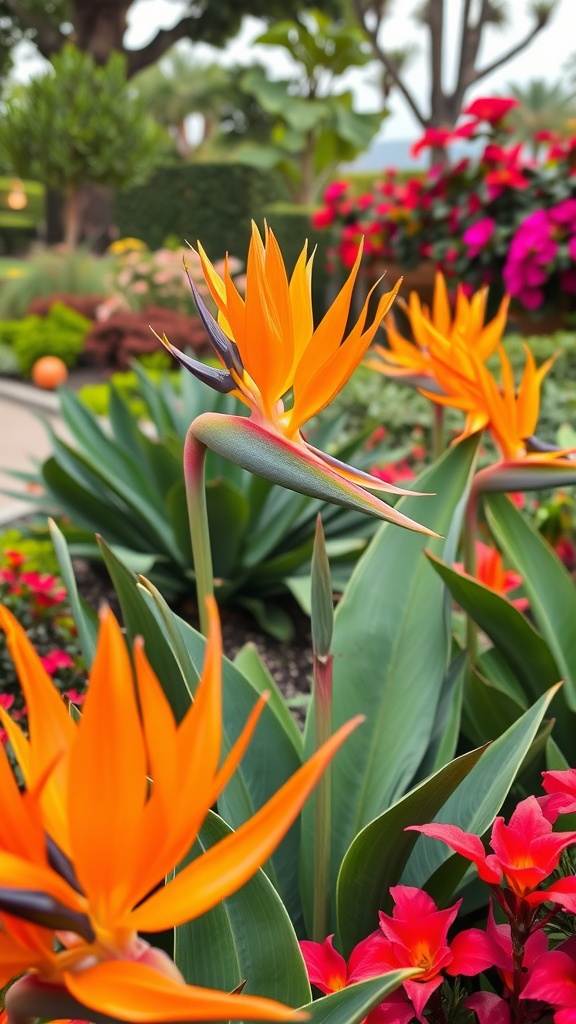
The Bird of Paradise plant makes a stunning focal point in any garden. Its bright orange flowers stand tall, resembling exotic birds in flight. This unique look captures attention and adds a touch of the tropics to your outdoor space.
In the image, you can see the vibrant flowers surrounded by lush green leaves and other colorful blooms. This creates an inviting and lively atmosphere. Placing these plants in strategic spots can draw the eye and enhance your garden’s overall beauty.
Consider grouping them in threes or fives for a more dramatic effect. They work wonderfully beside pathways or near seating areas, ensuring they’re always in view. With their striking appearance, Bird of Paradise plants not only serve as decoration but also spark conversation among visitors.
Colorful Borders with Bird of Paradise

Creating colorful borders in your garden can really bring it to life. The vibrant Bird of Paradise plants stand out with their bright yellow flowers, adding a tropical touch to any outdoor space.
The image showcases a well-defined garden pathway lined with these stunning plants. The bright colors of the flowers complement the green foliage beautifully, making the space feel inviting.
Using Bird of Paradise as border plants not only draws the eye but also creates a cheerful atmosphere. Imagine strolling down that path, surrounded by the lush greenery and pops of color, making your garden a true haven.
Attracting Pollinators with Bird of Paradise
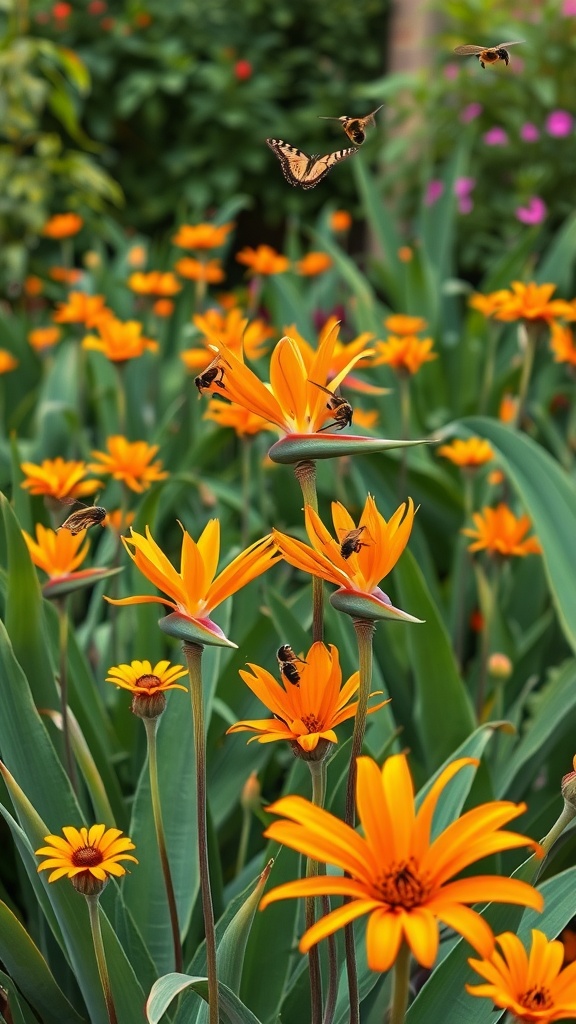
Bird of Paradise plants are not just stunning to look at; they also play a vital role in attracting pollinators like bees and butterflies. The image captures a vibrant scene filled with bright orange blooms, which are irresistible to these helpful creatures.
The delicate shapes of the flowers provide a perfect landing spot for butterflies, while the rich nectar inside is a delicious treat for bees. As these pollinators flit from flower to flower, they help with the reproduction of your plants, leading to a thriving garden.
Creating a space filled with Bird of Paradise can turn your garden into a lively hub of activity. The combination of colors and scents will invite bees and butterflies to visit frequently. This not only enhances the beauty of your outdoor space but also supports local ecosystems.
Rustic Charm with Bird of Paradise
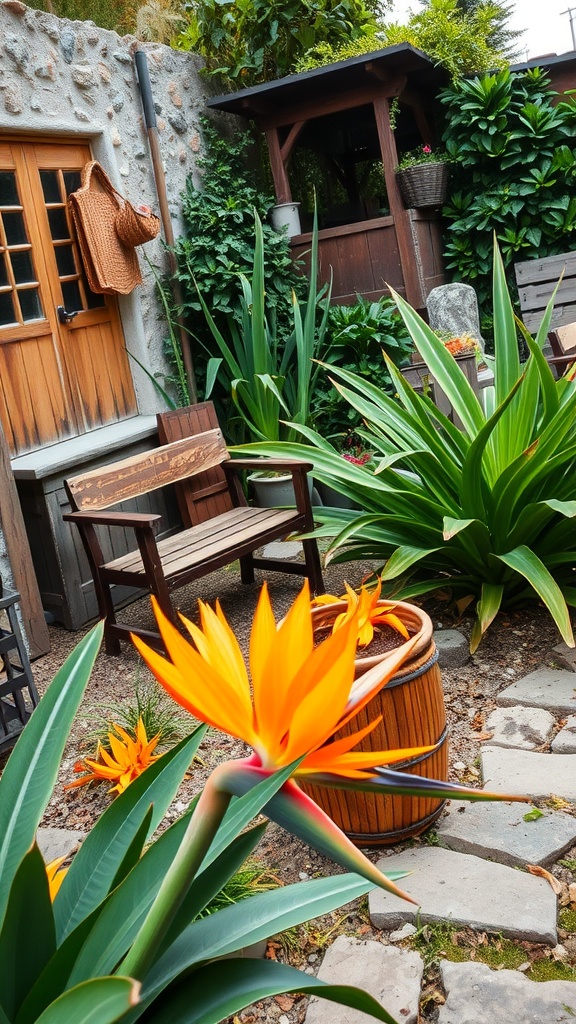
The image showcases a lovely garden corner featuring the stunning Bird of Paradise plant. With its vibrant orange flowers, this plant brings a sense of life and color to the rustic setting.
The wooden chair and barrel add a touch of warmth, making it a perfect spot to relax. The natural stone path leads the eye through the lush greenery, creating an inviting atmosphere. This blend of elements captures the charm of a cozy garden retreat.
Incorporating Bird of Paradise into your garden can enhance its beauty while maintaining a rustic feel. These plants thrive in well-drained soil and enjoy sunny spots, making them ideal for anyone looking to brighten up their outdoor space.
Bird of Paradise in Modern Landscapes

Bird of Paradise plants are a stunning choice for modern landscapes. Their vibrant flowers, resembling tropical birds in flight, add a splash of color and exotic flair to any garden. In the image, you can see these striking plants positioned beside sleek, contemporary stone walkways, creating a beautiful contrast with the clean lines of the architecture.
The combination of bright orange blooms and lush green leaves not only enhances the visual appeal but also brings a lively energy to the space. These plants thrive in well-drained soil, making them perfect for landscaped areas that aim for a polished look.
Incorporating Bird of Paradise into your garden design can make a strong statement. They work wonderfully in minimalist settings, where their unique shape and color can shine without overwhelming the space. The careful arrangement of these plants, alongside modern elements, showcases how nature can blend seamlessly with contemporary design.
Container Gardening with Bird of Paradise

Container gardening is a fantastic way to incorporate the stunning Bird of Paradise plants into your outdoor space. These vibrant plants add a tropical feel, making any area feel more inviting and lively. In the image, you can see beautiful Bird of Paradise flowers in elegant pots. Their bright orange and yellow blooms stand out against the lush green leaves, creating a striking visual.
When planting in containers, choose pots that are large enough to accommodate the roots of these plants. They thrive in well-draining soil, so ensure your pots have drainage holes. This helps maintain moisture without over-saturating the roots. You might also want to consider pairing them with other colorful plants for a mixed arrangement.
Position your containers in a spot that receives plenty of sunlight. Bird of Paradise loves the sun, and this will encourage vibrant blooms. Regular watering is important, especially during dry spells, but be careful not to let them sit in water. With the right care, these plants can bring a touch of the tropics right to your garden.
Bird of Paradise in Vertical Gardens

Vertical gardens are a stunning way to showcase the beauty of Bird of Paradise plants. These striking flowers add a splash of color and a tropical feel to any space. Picture a wall adorned with vibrant orange and green hues, instantly transforming a plain area into a lively focal point.
The image shows a creative arrangement of Bird of Paradise plants in pots mounted on a wall. The tall, lush leaves and bold flowers create a dynamic visual that draws the eye. This setup not only maximizes your space but also allows these beautiful plants to thrive.
Using vertical gardens for Bird of Paradise gives you versatility in design. You can combine different heights and colors, enhancing the overall aesthetic of your garden. Plus, they can be easily integrated into both indoor and outdoor settings, making them a great option for anyone looking to brighten their surroundings.
Tropical Oasis with Bird of Paradise
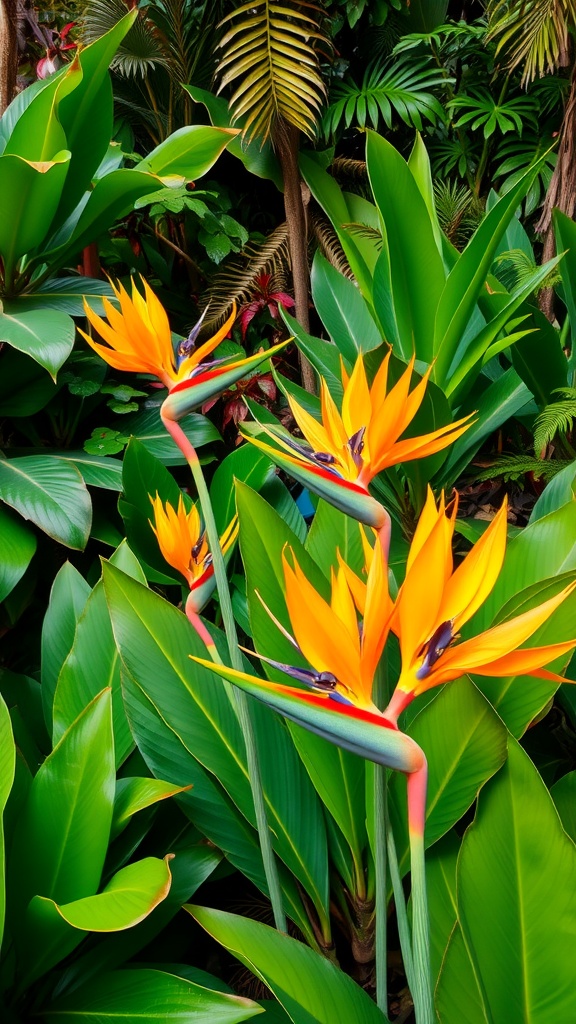
Imagine stepping into a vibrant world filled with color and life. The Bird of Paradise plant truly brings that tropical feel right into your garden. Its stunning flowers, with bright orange and blue hues, look like they are dancing among the lush green leaves. This beauty not only captures the eye but also adds a touch of exotic charm to any outdoor space.
When arranging these plants in your garden, think about grouping them for a striking effect. The bold colors of the Bird of Paradise pair beautifully with other tropical foliage, creating a lush environment. You can plant them near a patio or walkway to make your outdoor area feel like a vacation getaway.
These plants thrive in sunny spots, so consider their placement carefully. Ensure they get plenty of light while also providing enough space for them to grow tall and magnificent. With the right care, you can enjoy their unique beauty for years to come, transforming your garden into a tropical oasis.

Seasonal Care Tips for Bird of Paradise
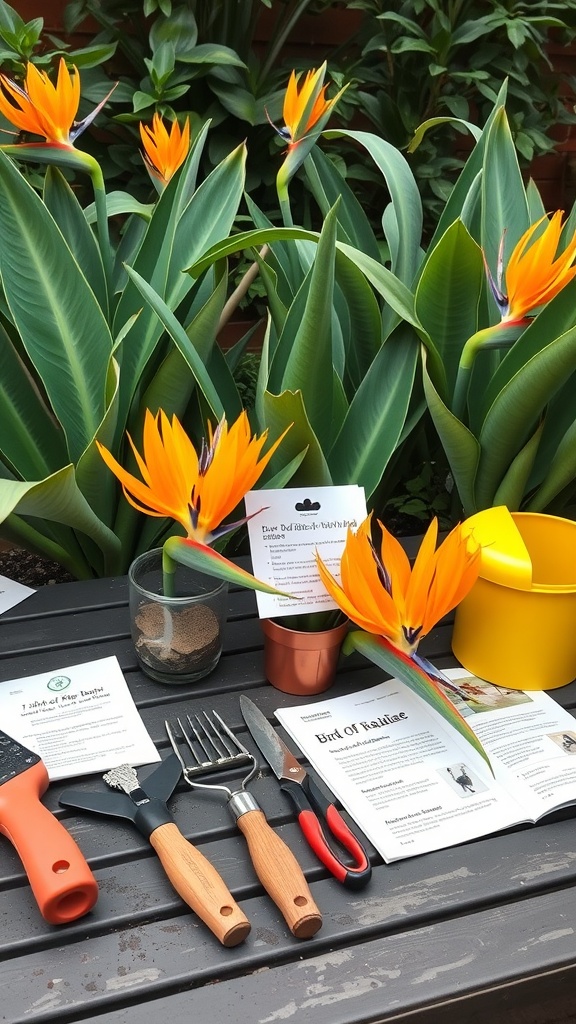
The Bird of Paradise plant is known for its vibrant flowers and lush foliage. In this section, let’s dive into caring for this stunning plant throughout the seasons. Just look at those bright orange blooms! They add a pop of color to any garden.
During spring, it’s time to focus on new growth. Water your plants regularly, keeping the soil moist but not soggy. This helps the roots establish. Fertilizing with a balanced fertilizer can also work wonders. You can see in the image some gardening tools that will help you with these tasks.
As summer approaches, ensure your Bird of Paradise gets plenty of sunlight. They thrive in bright, indirect light. If the heat gets intense, consider providing some afternoon shade. Use mulch around the base to help retain moisture and keep the roots cool.
In fall, it’s time to prepare your plant for cooler temperatures. Reduce watering and stop fertilizing. This helps the plant go into a restful state. You can still admire those gorgeous blooms, as they often last into the early fall.
When winter arrives, protect your plant if you live in a colder climate. Consider bringing it indoors or covering it if it’s in the ground. Allow it to rest, and check for any signs of pests. Your care will reward you with beautiful flowers when the weather warms up again.
